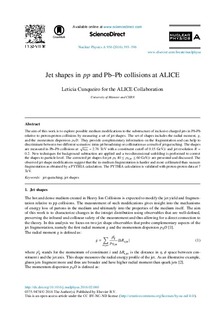Jet shapes in pp and Pb–Pb collisions at ALICE
Adam, Jaroslav; Adamová, Dagmar; Aggarwal, Madan M.; Aglieri Rinella, Gianluca; Agnello, Michelangelo; Agrawal, Nikita; Ahammed, Zubayer; Ahn, Sang Un; Aiola, Salvatore; Akindinov, Alexander; Alme, Johan; Helstrup, Håvard; Hetland, Kristin Fanebust; Kileng, Bjarte; Altinpinar, Sedat; Djuvsland, Øystein; Haaland, Øystein Senneset; Huang, Meidana; Lønne, Per-Ivar; Nystrand, Joakim; Rehman, Attiq ur; Røhrich, Dieter; Tambave, Ganesh Jagannath; Ullaland, Kjetil; Velure, Arild; Wagner, Boris; Zhang, Hui; Zhou, Zhuo; Zhu, Hongsheng; Arsene, Ionut Christian; Bätzing, Paul Christoph; Dordic, Olja; Lindal, Svein; Mahmood, Sohail Musa; Milosevic, Jovan; Qvigstad, Henrik; Richter, Matthias; Røed, Ketil; Skaali, Toralf Bernhard; Tveter, Trine Spedstad; Wikne, Jon Christopher; Zhao, Chengxin; Langøy, Rune; Lien, Jørgen; Alam, Sk Noor; Aleksandrov, Dimitry; Alessandro, Bruno; Alexandre, Didier; Alfaro Molina, José Rubén; Alici, Andrea; ALICE, Collaboration
Journal article, Peer reviewed
Published version
Permanent lenke
http://hdl.handle.net/11250/2507969Utgivelsesdato
2016Metadata
Vis full innførselSamlinger
- Institutt for mikrosystemer [546]
- Publikasjoner fra CRIStin [3623]
Sammendrag
The aim of this work is to explore possible medium modifications to the substructure of inclusive charged jets in Pb-Pb relative to proton-proton collisions by measuring a set of jet shapes. The set of shapes includes the radial moment, g, and the momentum dispersion pTD. They provide complementary information on the fragmentation and can help to discriminate between two different scenarios: intra-jet broadening or collimation as a result of jet quenching. The shapes are measured in Pb–Pb collisions at √sNN = 2.76 TeV with a constituent cutoff of 0.15 GeV/c and jet resolution R = 0.2. New techniques for background subtraction are applied and a two-dimensional unfolding is performed to correct the shapes to particle level. The corrected jet shapes for jet pT 40 ≤ pT,jet ≤ 60 GeV/c are presented and discussed. The observed jet shape modifications suggest that the in-medium fragmentation is harder and more collimated than vacuum fragmentation as obtained by a PYTHIA calculation. The PYTHIA calculation is validated with proton-proton data at 7 TeV.

